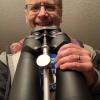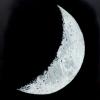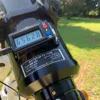
Celestron All-Star Alignment
#1

Posted 23 August 2013 - 12:54 PM
I was wondering does anyone have experience using Celestron's All-Star alignment method? I have a CG-5 mount. Thanks in advance for your comments!
#2

Posted 23 August 2013 - 01:19 PM
#3

Posted 23 August 2013 - 01:26 PM
As an example, a few days ago I set up and did an align using Ralalhague and Albeiro with Deneb as a single calibration star. This gave a polar align error of 2' 45" in Azm and -47' 01" in Alt.
I did an ASPA using Altair as the align star.
I cycled power and did the same 2+1 align using the same stars.
The polar align error was reported as 2' 41" in Azimuth and 1' 20" in Altitude.
The initial alignment was surprisingly good for putting the tripod down in more or less the same position as previous times but the final result is typical of what I seem to get, a polar align error of about 3 arc minutes. Taking a bit more care with the alignment, such as a few more stars, would have helped but I was in a hurry.
The difference is that I was using an AVX but the hand control software is identical so results should be comparable with the CG5.
BTW, there's no need to do the power cycle and second alignment, I did that because I wanted to check what sort of polar alignment error I had.
Chris
#4

Posted 23 August 2013 - 01:33 PM
What alignment and sync stars would you recommend for someone living near Columbus, Ohio?
#5

Posted 23 August 2013 - 03:30 PM
Stan
#6

Posted 23 August 2013 - 03:50 PM
The program will choose the stars for you. If you do not like the stars that are choosen press undo/back and scroll until you find one you like. If you still don't see a star you like press the up/down button and scroll through a complete list of stars available.
Stan
Not exactly. The HC will present you with _go-to_ alignment star choices. You select the star for AllStar yourself from the lists in the HC.
#7

Posted 23 August 2013 - 04:14 PM
As an example, a few days ago I set up and did an align using Ralalhague and Albeiro with Deneb as a single calibration star. This gave a polar align error of 2' 45" in Azm and -47' 01" in Alt.
I did an ASPA using Altair as the align star.
I cycled power and did the same 2+1 align using the same stars.
The polar align error was reported as 2' 41" in Azimuth and 1' 20" in Altitude.
I am surprised to hear this. I have never used ASPA but have heard that it is very accurate. This demonstration shows otherwise. I will have to try this myself and see what I come up with "just becasuse". Has anyone else tried this excersize to test the accuracy of ASPA?
#8

Posted 23 August 2013 - 04:58 PM
i think ASPA is pretty accurate if you can consistently center the star using long focal lengths.
i don't have an illuminated eyepiece, but i use my dslr and byeos for centering instead. because my polar alignment is normally pretty far off initially (can't really see polaris where i am), i do a 2+1 alignment to determine roughly what the polar align error is. i make adjustments based on the numbers, realign the 3 stars, check the numbers and make another adjustment. after that, i cycle the power and do a full 2+4 alignment and then ASPA (most people who recommend ASPA also recommend doing 2+4 alignments when doing it).
With this I can manage 5 minute drift alignments (using the ccd method) and got straight lines for both stars using the c90 (1250mm). So i think that's pretty good.
Only did it twice though (the ccd drift align), but i think the aspa is accurate enough that i don't need to drift align again (as long as i'm centering the star as accurately and consistently as possible).
edit: make sure that your gotos are accurate before doing aspa. if your gotos aren't even close to where they should be, then that will probably screw up your polar alignment. i think my gotos were off because i was aligning on the wrong stars. setting the wrong time zone didn't help either.
#9

Posted 23 August 2013 - 05:08 PM
Good luck,
#10

Posted 23 August 2013 - 05:10 PM
This is useful information as I don't have an illuminated eyepiece either. I'm also a beginner and I'll also be using BYEOS for centering through my DSLR.
Do you think I can get 5-minutes subs with this approach using my 400mm lens on my DSLR?
#11

Posted 23 August 2013 - 10:11 PM
i've heard people being able to get 5-min subs at 400mm with the cg-5 and other similar mounts, so it should be doable with the vx.
#12

Posted 24 August 2013 - 03:18 AM
I think ASPA will be accurate to a few arc minutes when done with 2+3 or 2+4 - but 2+1 could be off.
If a mount has switches to mark the axis indices, like on a cge-pro, then a 2+0 may be more accurate than a 2+1 - if the mount had previously been well calibrated with a 2+4. That's because a 2+0 will use the previous calibration info and just use the 2 stars to measure the current polar alignment, whereas a 2+1 will overwrite the previous good calibration info with new, inferior data based on only one calibration star.
If the mount doesn't have axis switches, then a 2+1 may be better than 2+0 - and may be perfectly adequate for visual work and goto accuracy. But 2+3,4 would be better if either setting a good polar alignment, or measuring it, is the goal.
Frank
#13

Posted 24 August 2013 - 04:51 AM
I'd like to see the CN naysayers do better in 2 minutes with no polar align scope.
2+0 should in theory give a good alignment and the ability to polar align using a star on the same side of the meridian as the align stars. You need at least one star on the other side to determine the cone error, or, as Frank says, use the cone error inherited from a previous alignment.
Switches should not make a difference because you start at the align position and while this may not be as accurate as switches once you have two stars the mount has enough information to calculate the Ra and Dec offsets and the start position doesn't matter.
I always use a cross hair EP. It's a 25mm Plossl with hairs glued across the field stop. Once I start aligning I don't move it, or refocus. This gives me consistent pointing. I don't think that's possible with centering a star by eye, not even if it's defocused.
Chris
#14

Posted 24 August 2013 - 05:14 AM
Switches should not make a difference because you start at the align position and while this may not be as accurate as switches once you have two stars the mount has enough information to calculate the Ra and Dec offsets and the start position doesn't matter.
This is unfortunately an issue that is completely lost in these discussions. Although cone is considered an important part of the calibration, the dec. offset is considered a trivial thing that only affects pointing to the alignment stars. This is not true. Knowing the dec. offset accurately is critical to good pointing - and to a good measurement of the polar alignment. I don't know how accurately the dec. index is set by a human manually aligning a mount without switches, but it would need to be accurate to a small fraction of a degree - because it is critical.
The two alignment stars do not tell you the dec. offset - it comes from the calibration - and the calibration needs to be good.
The RA switch offset is not critical and it is set by the alignment stars, but the dec. offset is different.
Multiple calibration stars help clarify the dec offset value - which presumably is different every time you manually align to the index mark. Changes in this value are another reason it is desirable to avoid powering off the mount and losing that value.
None of what I'm saying should detract from the accuracy of ASPA when it is done with 2+3 or 2+4 - which I expect to be within a few arc-minutes and adequate for long exposure guided imaging (as I do with my cge and cge-pro). But the accuracy is reduced a lot if you just use 2+1.
Frank
#15

Posted 24 August 2013 - 05:52 AM
Sorry to mislead people.
Chris
#16

Posted 24 August 2013 - 06:21 AM
These details don't matter as long as people regard the calibration stars as "cone/dec. offset calibration stars" - and you need many of them to calibrate the mount well. When you power off the mount and manually set the index mark, the cone value should not be changed because it is independent of the index mark - but the dec. offset will change. With switches I think the position is accurate to a few arc-minutes or so - and even that is a big amount and might warrant doing a fresh 2+4 when you start up (for best accuracy anyway). And for one with manual index settings to a mark, it needs to be set very carefully if you want good pointing with 2+0 after you power up. So I would avoid powering off entirely after doing 2+4 and ASPA. If you do power off, do another 2+4 for best accuracy, or to measure the new polar alignment error.
Frank
#17

Posted 25 August 2013 - 12:47 PM
The two alignment stars do not tell you the dec. offset - it comes from the calibration - and the calibration needs to be good.
The RA switch offset is not critical and it is set by the alignment stars, but the dec. offset is different.
Multiple calibration stars help clarify the dec offset value - which presumably is different every time you manually align to the index mark. Changes in this value are another reason it is desirable to avoid powering off the mount and losing that value.
None of what I'm saying should detract from the accuracy of ASPA when it is done with 2+3 or 2+4 - which I expect to be within a few arc-minutes and adequate for long exposure guided imaging (as I do with my cge and cge-pro). But the accuracy is reduced a lot if you just use 2+1.
I didn't realize this but it makes perfect sense. Good information here. Thank you.
#18

Posted 26 August 2013 - 01:09 AM
in a perfect world an OTA is parallel with the RA axis and only two stars would be needed but guess what we live in an imperfect world and having the up to 4 calibration stars allows the mount to measure and average this error in the mount+optical train in use.
#19

Posted 26 August 2013 - 02:25 AM
You also need to know the RA offset, and the polar alignment error in alt/az. That is a total 5 parameters to figure out, and two stars isn't adequate. To know them accurately, you need many more.
The polar alignment error and RA offset have to do with the orientation of the mount and not its inherent mechanical properties - so they are not part of the mount calibration.
Once the mount is calibrated and you know the cone/dec. offset accurately, you can do a 2+0 alignment without recalibrating - and all you need to figure out is the polar alignment error in alt/az, plus the RA offset - and that is ok with two stars. But it assumes the cone and dec. offset are accurate, which is only true if the dec. index was set accurately after power up. Cone shouldn't change.
Frank






















